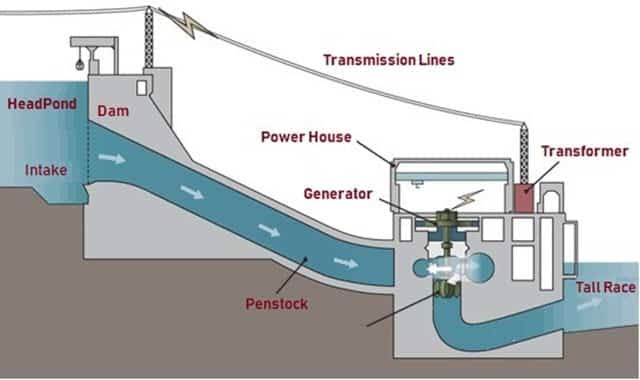
A dam works as a structure built to control the flow of water, typically in a river or stream. It serves several purposes, including water storage, flood control, irrigation, hydroelectric power generation, and recreation. Here’s how a dam typically works:
Basic Components of a Dam:
- Reservoir: The large body of water that accumulates behind the dam, created by the blockage of a river or stream. The water in the reservoir can be used for various purposes, such as irrigation, drinking water, and hydroelectric power generation.
- Dam Wall: The main barrier that holds back the water, made of materials like concrete, earth, or rock. The dam wall can vary in design depending on its purpose and the landscape.
- Spillway: A controlled exit for excess water when the reservoir reaches full capacity, preventing overflow and damage to the dam. Water spills over the spillway or is released through gates to safely manage water levels.
- Penstock (for Hydroelectric Dams): A large pipe that carries water from the reservoir to turbines inside the dam. The flow of water through the penstock generates power when it moves the turbines.
- Turbines and Generator (in Hydroelectric Dams): As water flows through the penstock, it spins turbines connected to generators. The mechanical energy from the turbines is converted into electrical energy.
- Outlet Works: Structures that release water from the reservoir for purposes like irrigation, municipal water supply, or power generation.
Working of a Dam:
- Water Storage: The dam impounds (blocks) the natural flow of a river or stream, creating a reservoir that stores water. This stored water can be controlled and released when needed.
- Controlled Release: The amount of water released from the dam is controlled through gates or valves. If the dam is used for hydroelectric power generation, water is released in a controlled manner to pass through turbines. If the dam is for irrigation or municipal water supply, water is released to those systems as needed.
- Hydroelectric Power Generation (if applicable): In a hydroelectric dam, when water is released through the penstock, it flows with significant pressure, causing turbines to spin. The spinning turbines generate mechanical energy, which is then converted into electrical energy by a generator. This electricity is transmitted to power grids.
- Flood Control: Dams help prevent downstream flooding by controlling the amount of water flowing through rivers. In cases of heavy rain or snowmelt, the dam can store excess water in the reservoir and release it gradually through the spillway or controlled gates to prevent overflow and downstream damage.
- Irrigation and Water Supply: In agricultural regions, the stored water is used for irrigation during dry periods, allowing crops to grow. Dams also provide a steady source of drinking water to cities and towns.
In Summary:
- Water is stored behind the dam in a reservoir.
- Controlled releases of water help prevent flooding and provide water for power generation or human use.
- Hydroelectric dams use water flow to generate electricity by spinning turbines connected to generators.
- Spillways manage excess water to prevent overflow and structural damage.
This process allows a dam to play a key role in water management, energy production, and protecting communities from floods.

Leave a Reply